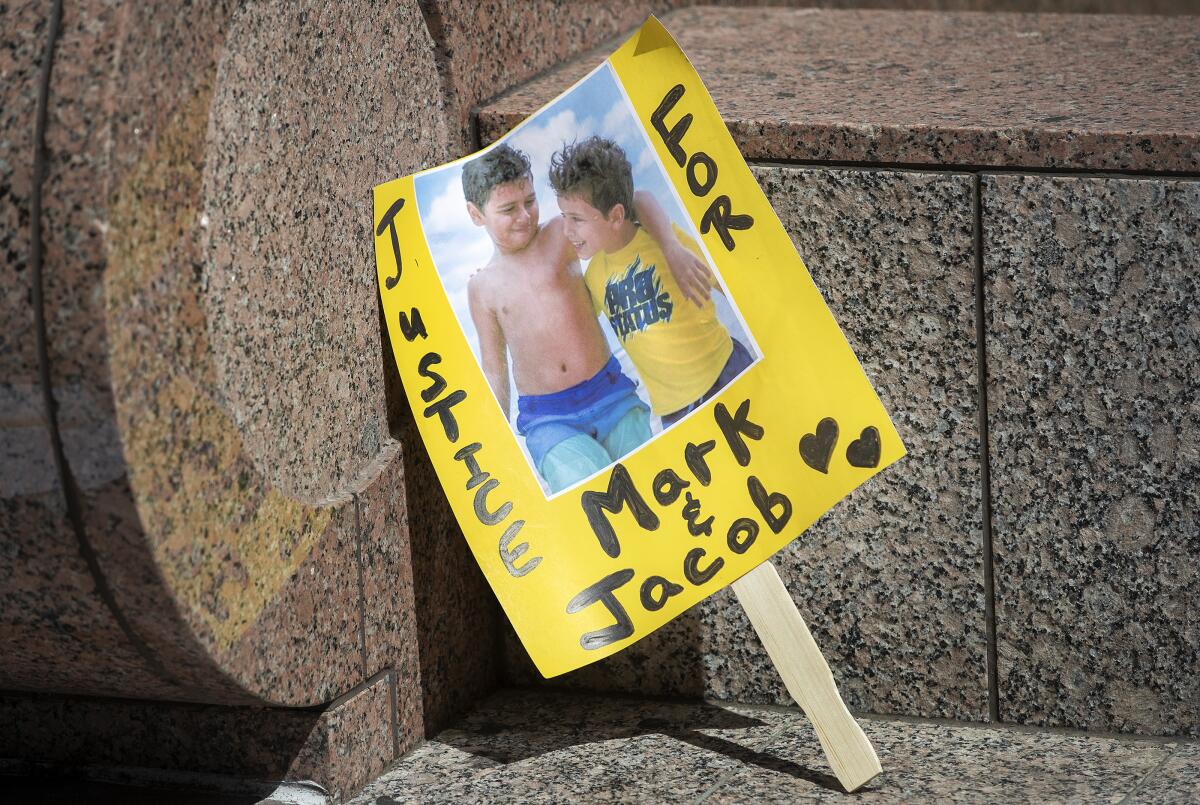Newsletter: The regulations and road designs that could have stopped Rebecca Grossman

Good morning. Iâm Paul Thornton, and it is Saturday, June 15, 2024. Hereâs what weâve been doing in Opinion recently.
Rebecca Grossman â convicted last February of second-degree murder for crashing into and killing two children in Westlake Village, then attempting to flee â was sentenced this week to 15 years to life in prison. Her trial drew widespread attention because of who she is (the wealthy co-founder of the Grossman Burn Center in Sherman Oaks) as much as the heartbreakingly young age of the victims, the grief-stricken parents and the callousness of leaving children on the road to die.
Your mileage may vary on the appropriateness of Grossmanâs sentence. But if you experience our streets as a walker, cyclist or anything other than a driver, you might see aggravating factors besides Grossmanâs willful recklessness: the kind of dangerous road design and lack of vehicle regulations that mean many more children crossing many more streets will die. Putting Grossman in prison until her mid-70s wonât change that.
The facts of this case have been recited ad nauseam: In September 2020, Grossman and her friend Scott Erickson, a former Major League Baseball pitcher, left a local restaurant and raced in their respective SUVs on the suburban streets of upscale Westlake Village. Evidence at the trial showed Grossman drove up to 81 mph in areas where the posted speed limit was 45, and she was going 73 mph when she hit and killed Mark and Jacob Iskander (ages 11 and 8), who were in a marked crosswalk with their mother and youngest brother. Grossmanâs car stopped a half-mile away, only because of a safety feature that prevents the engine from running after airbag deployment.
Aside from the hit-and-run, most people fixate on Grossmanâs willfully insane speed. But itâs not like the street where the Iskander brothers were hit, Triunfo Canyon Road, facilitates vehicle speeds safe for a residential neighborhood. Many of the roads in that area and in other suburbs are wide and have long distances between stop signs and traffic lights that all but beg drivers to exceed the already high speed limits. To Westlake Villageâs credit, that city installed flashing signals at the crosswalk where the children were killed â but one reader recently pointed out in a letter to the editor that no measures have been taken to actually slow traffic on that road.
And if a better-designed road could have made it harder for Grossman to drive 81 mph, off-the-shelf technology could have prevented her from going anywhere near that. Speed governors are already common in much of the world, and many new cars sold right here in the U.S. come with them â theyâre just set to homicidally high limits such as 130 mph. A bill passed by the California Senate last month would require all new cars sold here to have âpassiveâ speed limiters by 2024, meaning they would give audible warnings when the posted limit is exceeded by 10 mph. With this technology, Grossman could have still driven at suicidal speeds, but she would have been annoyed by an audible warning starting at 55 mph.
Then thereâs Grossmanâs car, a Mercedes-Benz 430 GLE sport utility vehicle. This roughly 5,000-pound vehicle, which has a 350-horsepower engine, would have been considered decadently large and overpowered 30 years ago. Now, youâd probably call it a âsmallâ SUV for getting around town. As The Times editorial board noted last year, SUVs and trucks, which are heavier and taller than sedans and come with larger blind spots, make up about 80% of car sales in the U.S. â and more pedestrians and cyclists are paying for that with their lives.
The federal government could regulate vehicle size to enhance pedestrian safety. For an example, look to the European Union, where Teslaâs own chief engineer said design regulations meant to protect pedestrians will make its cartoonishly jagged Cybertruck a tough sell. Last year, the National Highway Traffic Safety Administration unveiled a proposal to consider pedestrian protection in its vehicle safety ratings â but bizarrely, it wonât use that information in its âfive-starâ car rating system. I suppose that counts as progress in a country that regulates safety only for people inside cars and not those they may hit on the outside.
We put people into large, powerful vehicles on wide-open roads, and hope that respect for the law and human life will persuade them to drive safely in all circumstances. Judging by the worsening pedestrian and cyclist death crisis on our roads today, this approach is failing catastrophically.
The Supreme Court keeps medication abortion safe â for now. In tossing out the lawsuit challenging the FDAâs approval of mifepristone, the Supreme Court didnât protect access to abortion (gutted with its Dobbs decision in 2022) or rule on the drugâs safety; it merely said the plaintiffs had no standing to sue. âAbortion medication will end up in court again,â warns the editorial board. âOther plaintiffs will argue they have standing to fight to curtail abortion procedures.â
What a relief. The Supreme Court did the right thing on mifepristone. UC Berkeley School of Law Dean Erwin Chemerinsky echoes the editorial board: âThe courtâs decision is a relief for those who support abortion rights, but it does not change the reality that overruling Roe vs. Wade has led to laws severely restricting reproductive healthcare, including medically induced abortions, in two dozen states. And there is no doubt that antiabortion forces will continue to look for ways to try to restrict the availability of mifepristone, including in lawsuits brought by state governments that already are pending.â
Enjoying this newsletter? Consider subscribing to the Los Angeles Times
Your support helps us deliver the news that matters most. Become a subscriber.
The LAUSD should ban smartphones in schools. Board of Education member Nick Melvoin introduced a resolution to ban student cellphones during the school day. In an op-ed article for The Times, he explains his reasoning: âJust as we ban harmful substances like tobacco and alcohol in schools, we must also implement a districtwide protocol that addresses the adverse effects smartphones and social media have on kids. By going phone-free, LAUSD can help restore learning environments that foster focus, social connectedness and healthy development.â
Donald Trumpâs advice on drinking and drugs is âDonât start.â So whatâs wrong with that? Sean Daniels, a person in long-term addiction recovery, says the former president is right: If youâre worried about substance misuse, donât start using substances. But in a a culture where drug and alcohol use is pervasive, that advice can be dangerous. He writes: âIâve spent 12 years in various recovery rooms and heard hundreds of thousands of deeply diverse narratives of addiction and sobriety, Iâve never heard someone say, âNancy Reagan said, âJust say no,â and that was the day I quit forever.ââ
More from this week in opinion
From our columnists
- Robin Abcarian: How a pious lifeguard made L.A.âs beaches an unlikely battlefield in the culture wars
- Jackie Calmes: We donât need more evidence of Justice Alitoâs bias, but we got it
From the Op-Ed desk
- Are the campus protesters angry enough with Biden to vote for Trump?
- The Supreme Court went out of its way to ignore common sense on bump stocks
From the Editorial Board
- Homeless people are dumped all the time â Burbank police just got caught
- Internet access is not a luxury. Congress should extend connectivity aid program
- The history, and hypocrisy, of the upside-down American flag
Letters to the Editor
- The fascinating Mojave Desert town thatâs in the solar industryâs crosshairs
- Abortion rights are safe in California? Donât be so sure
- What halting diversity programs looks like to a 90-year-old Black woman
Stay in touch.
If youâve made it this far, youâre the kind of reader whoâd benefit from subscribing to our other newsletters and to The Times.
As always, you can share your feedback by emailing me at [email protected].
A cure for the common opinion
Get thought-provoking perspectives with our weekly newsletter.
You may occasionally receive promotional content from the Los Angeles Times.




